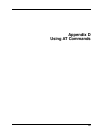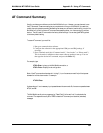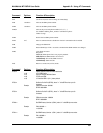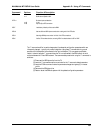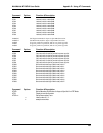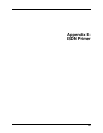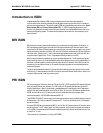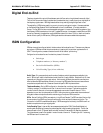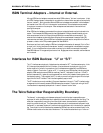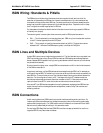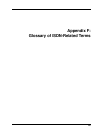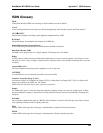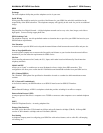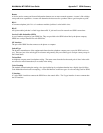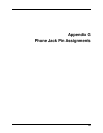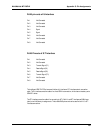
MultiMobile MT128ZLX User Guide Appendix E: ISDN Primer
244
ISDN Wiring: Standards & Pitfalls
The ISDN service on the telco side of the demarc must be conveyed to the wall jack from which the
subscriber will be accessing the ISDN service. However, some telephone wiring in both residential and
commercial buildings are unsuited to ISDN use. For example, some surplus wires may already be use for
analog lines, to power the lights on phones with illuminated dialing buttons. Telephone wires in a “daisy-
chain” configuration are also inappropriate for ISDN use.
For these reasons, the subscriber should check with the telco to be sure the wiring proposed for ISDN use
will actually work properly.
There are two types of connector jacks that are commonly used for ISDN physical connections:
• RJ11 — This is the standard four-wire analog phone jack. ISDN wiring from the subscriber’s wall box
to the NT-1 device is generally done with RJ11 jacks.
• RJ45 — This is an eight-wire jack that is somewhat wider than the RJ11. The physical connection
between the NT-1 device and the ISDN adapter typically is outfitted with RJ45 jacks.
ISDN Lines and Multitple Devices
A single ISDN line can have up to eight devices connected to it. The list of devices that you may attach to an
ISDN line include bridges, routers, Group 4 ISDN fax machines, ISDN telephones and analog telephone
devices. Because ISDN is capable of routing incoming calls between the two B-channels, up to two devices
may be used simultaneously.
By using a network bridge or router, a single ISDN line can be shared on a LAN in order that all computers
on the LAN can make use of it.
As previously mentioned, multiple ISDN devices can be connected to a single ISDN line. For example you
could have an internal ISDN TA installed in your computer and Group 4 fax machine both connected to the
same ISDN line. This would allow you to surf the internet and accept incoming voice calls and faxes at the
same time. For this configuration to work, an NT-1 that supports multiple S/T interface connections
would be required and each device would have to be connected to the NT-1. Each device would also be
required to have it’s own SPID in order that the calls could be routed to the correct device.
Also, some NT-1s or ISDN devices are capable of converting between an analog signal and ISDN and can
support the use of traditional analog devices such as telephones, modems, Group 3 fax machines, and
answering machines.
ISDN Connections
As with most digital services, ISDN is sensitive to outside interference and has certain restrictions. For
instance, such factors as the distance from the telephone company’s central office and the grade of cable
used can affect the signal quality. For ISDN lines,the maximum distance from the central office is 18,000
feet and normally uses twisted pair cabling for its transmission media.
For small sites, ISDN-Basic Rate Interface (ISDN-BRI) would be most appropriate while for medium to
large sites ISDN-Primary Rate makes more sense.



